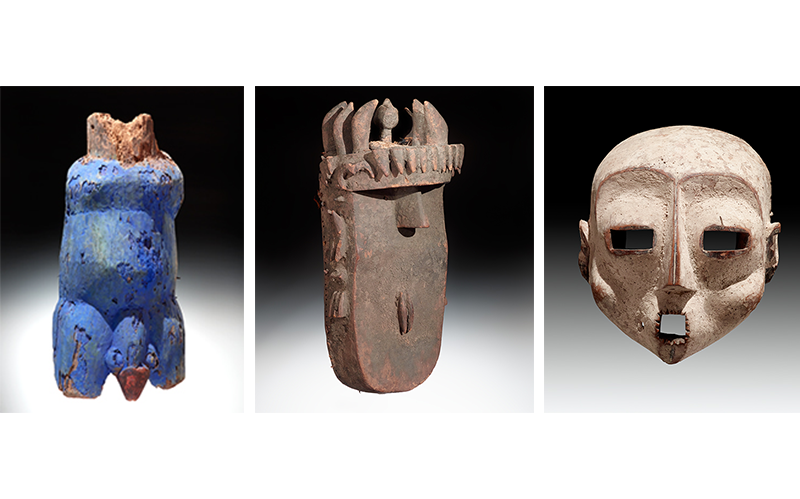
The Tribal Art auction in June features three magnificent African masks from the collection of Carlo Monzino, who was as passionate as collector of contemporary works as he was of African art. The items testify to the richness of African sculpture in terms of surface treatment.
Their magic lies in their surface
One thing painting and African sculpture have in common is that their magic lies in the surface. Painting evokes the freedom of texture, capturing light through a sfumato technique, which makes the artwork appear veiled, or by applying paint in a thick impasto. A painting’s strength rests on its ability to create fictional, three-dimensional space on a two-dimensional plane, albeit in its abstraction. African sculpture takes it one step further: in charging the object with life and magic, the surface becomes a living skin.
Colour matters
Many sculptures from Nigeria to the Congo are covered in a combination of white, red and black, with every one of these hues signifying part of the local belief system.
White
White colour is made of calcium deposits, clay or crushed seashells. It is mostly used on masks, which are cleaned and repainted for each ceremony, typically with pigment that contains tiny specks of mica to reflect the light. The colour white often signifies death, a sick person losing complexion, but also the transparency of fog, foam on the sea, clouds that disperse. The Idumu mask from the Congo represents a high social rank and ancestral power.
Red
Red colouring is made of ochre and is mainly derived from coral tree bark, which is treated and dried until it becomes a thick paste that can be used as a cosmetic or rubbed on figures. It evokes strength, blood and fire.
Black
Black is often a mix of charcoal and blood to make it stick and literally give life to the magical objects. The large Toma mask was also given a magic charge through the treatment of the wood. Often such pieces were “blackened” in Europe to create a shinier, art deco surface. This shiny, waxed surface could also be seen on another mask from the same collection, which was auctioned by Christies last year.
Blue
The colour blue is very rare in African sculpture. The present, unique body mask is from the renowned Aga Khan Collection. In the 19th century the rich kingdoms of Nigeria loved the intense blue pigment, which was even introduced as a trade currency. Only the most important objects were treated with this rare and expensive material. Blue was also the royal colour in Europe for centuries – a rare pigment that was only used for the most exquisite of paintings. The famous body mask shows layer upon layer of pigment. Though the mask was damaged by insects and weather, it was considered so historically important that new layers of precious blue were added to it.
Each wooden sculpture reveals a world of richness in its surface. The thin layers of colour were applied to protect them from the elements, enliven their role in the cultural context, and link them to other dimensions.
Jan Joris Visser is Dorotheum’s specialist in tribal art.
Auction
Tribal Art
21 June 2018, 4 pm
Preview: 16 – 21 June 2018
Palais Dorotheum
Dorotheergasse 17
1010 Vienna













